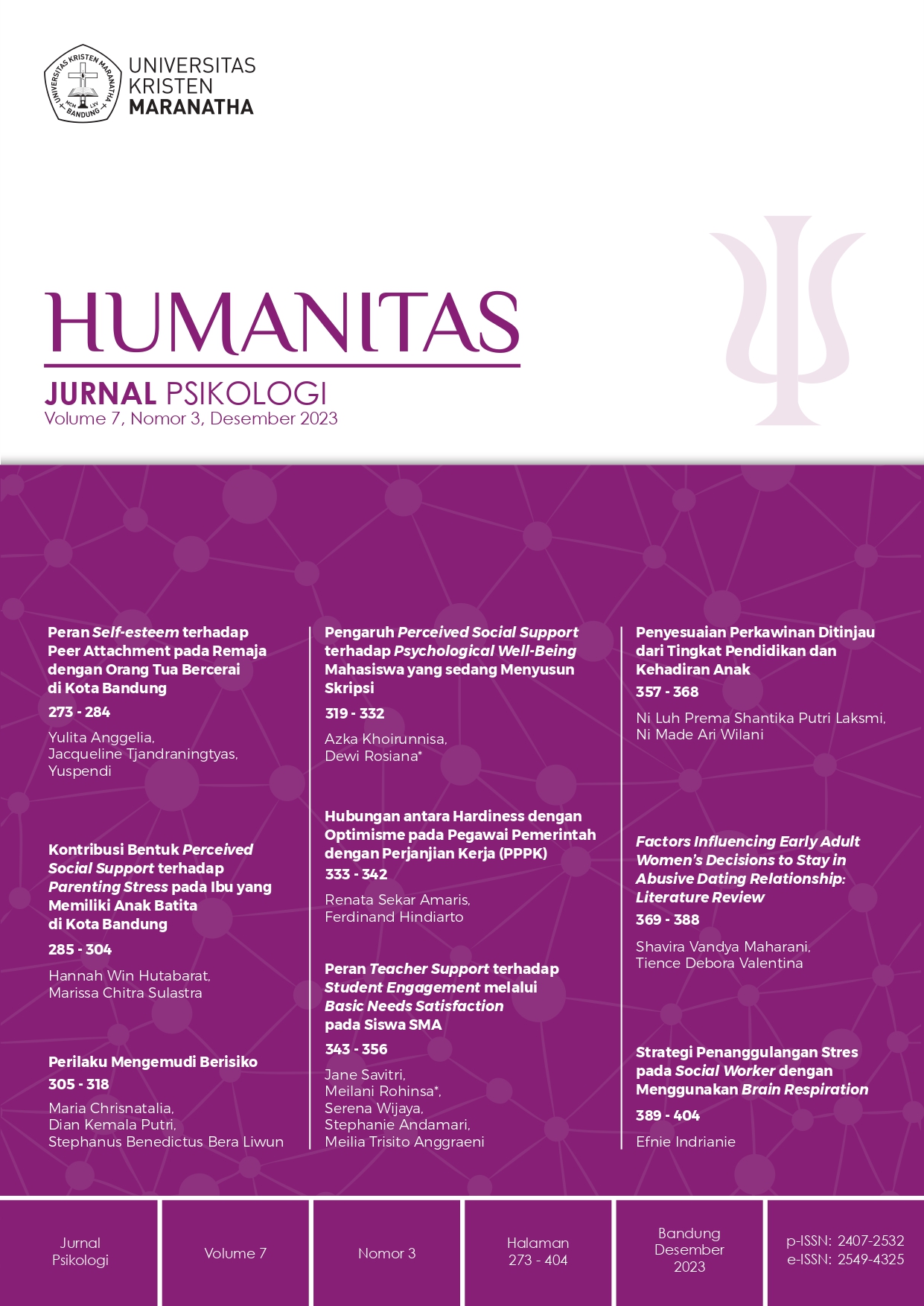The Influence of Self-Esteem on Peer Attachment among Adolescents with Divorced Parents in Bandung City
Main Article Content
Abstract
Downloads
Article Details

This work is licensed under a Creative Commons Attribution-NonCommercial 4.0 International License.
References
Adiyanti, M. G., & Laumi. (2012). Attachment of Late Adolescent to Mother, Father, and Peer, with Family Structure as Moderating Variable and their Relationships with Self- esteem. Jurnal Psikologi.
Armsden, G. C., & Greenberg, M. T. (1987). The Inventory of Parent and Peer Attachment: Individual Differences and Their Relationship to Psychological Well- Being in Adolescence. Journal of Youth and Adolescence.
Armsden, G. C., McCauley, E., Greenberg, M. T., Burke, P. M., & M. R. (1990). Parent and Peer attachment in Early Adolescent Depression. Journal of Abnormal Child Psychology.
Bowlby, J. (1990). A Secure Base: Parent-Child Attachment And Healthy Human Development. London: The Hogarth Press.
Bowlby, J. (1973). Attachment and loss vol.2: Separation. New York: Basic Book.
Cassidy, J., & Shaver, P. R. (Eds.). (2016). Handbook of attachment: Theory, research, and clinical application third edition. The Guilford Press. United States of American.
Creswell, W. J., & Creswell, J. D. (2018). Research design: Qualitative, quantitative, and mixed methods approaches. Sage Publications.
Esmaeili, S. N., & Yaacob, S. N. (2012). Correlates of Self-esteem among Adolescents of Divorced Families. Archives Des Sciences.
Fitri, S., & Kusumaningtyas, A. (2019). Pengembangan Buku Bantuan Diri untuk Membantu Remaja Memelihara Ikatan Kelekatan (Attachment Bond) yang Orang tuanya Bercerai SMA se-DKI Jakarta. Insight: Jurnal Bimbingan dan Konseling.
Gergiou, M., & Meins, E. (2010). Relations between Peer Attachment, Self- Esteem, and Perceived Parental Bonding in Greek Cypriot and British Young Adults. The Cyprus Review.
Gorrese, A., & Ruggieri, R. (2012). Peer Attachment: A Meta analytic Review of Gender and Age Differences and Associations with Parent Attachment. Journal of Youth and Adolescence.
Gorrese, A., & Ruggieri, R. (2013). Peer attachment and self-esteem: A meta- analytic review. University of Salerno. Italy.
Gorrese, A. (2015). Peer attachment and Youth Internalizing Problems: A Meta- Analysis. Child Youth Care Forum.
Harris, M. A., & Orth, U. (2020). The link between self-esteem and social relationships: A meta-analysis of longitudinal studies. Journal of Personality and Social Psychology.
Hood, N. J., Jacobson, P. R., & Jacobson, J. L. (2017). The Impact of Self- Esteem and Empathy on the Relationship between Workplace Bullying and Attachment Style. Review of Integrative Business and Economics Research.
Krider, D. (2002). Self-esteem in Young Adults: The Effects of Parental Divorce in Childhood. IU South Bend Undergraduate Research Journal.
Lim, Y. (2020). Self-esteem as a mediator in the longitudinal relationship between dysfunctional parenting and peer attachment in early adolescence. Children and Youth Services Review.
Lee, B., & Park, J. H. (2016). The Longitudinal Relationship Between Self-esteem and Peer Relationship in Adolescence: Using Autoregressive Cross-Lagged Modeling. Korean Journal Child Study.
Marshall, S. L., Parker, P. D., Ciarrochi, J., & Heaven, P. C. L. (2014). Is self-esteem a cause or consequence of social support? A 4-year longitudinal study. Child Development, 85, 1275–1291.
Mruk, J. C. (2013). Self-esteem and Positive Psychology. Research, Theory, and Practice Fourth Edition. Springer Publishing Company. LLC.
Murray, S. L., Hohnes, J. G., Griffin, D. W., Bellavia, G., & Rose, P. (2001). The mis- measure oflovc: How self-doubt contaminates relationship beliefs. Personality and Social Psychology Bulletin.
Park, M. K., & Park, H. (2015). Effects of Self-esteem Improvement Program on Self-esteem and Peer attachment in Elementary School Children with Observed Problematic Behaviors. Asian Nursing Research.
Reasoner, W. R. (1983). Enhancement of self-esteem in children and adolescents. Moreland School District.
Robins, R. W., & Trzesniewski, K. H. (2005). Self-esteem development across the lifespan. Current Directions in Psychological Science, 14(3), 158–162.
Santrock, J. W. (2016). Adolescence 6th Edition. McGraw-Hill Education. New York.
Schaan, K. V., Schulz, A., Schächinger, H., & Vogele, C. V. (2019). Parental divorce is associated with an increased risk to develop mental disorders in women. Journal of Affective Disorder.
Schoeps, K., Monaco, E., Cotolí, A., & Castilla, I. M. (2018). The impact of peer attachment on prosocial behavior, emotional difficulties and conduct problems in adolescence: The mediating role of empathy. Department of Personality, Assessment and Psychological Treatment. University of Valencia. Spain.
Shariff, S. A. M., Hilmi, A. R. R. M., Sultan M. R., & Ilya Y. I. (2021). The Effects of Divorce Parents on Child’s Behavior. E-journal of Media & Society.
Szczesniak, M., Bielecka, G., et al. (2022). The Role of Self Esteem in the Relationship Between Loneliness and Life Satisfaction in Late Adulthood: Evidence from Poland. Psychol Res Behav Manag.
Vanhalst, J., Luyckx, K., Scholte, R. H. J., Engels, R. C. M. E., & Goossens, L. (2013). Low Self-esteem as a Risk Factor for Loneliness in Adolescence: Perceived - but not Actual – Social Acceptance as an Underlying Mechanism. Journal Abnormal Child Psychology. Springer Science & Business Media New York.
Xiuqin, T., Guirong, L., & Tingzhu, S. (2018). Influence of Teacher-Student Relationship on Junior High Students' Academic Achievements: Mediating Role of Self-esteem. Advances in Social Science, Education and Humanities Research. Atlantis Press.

